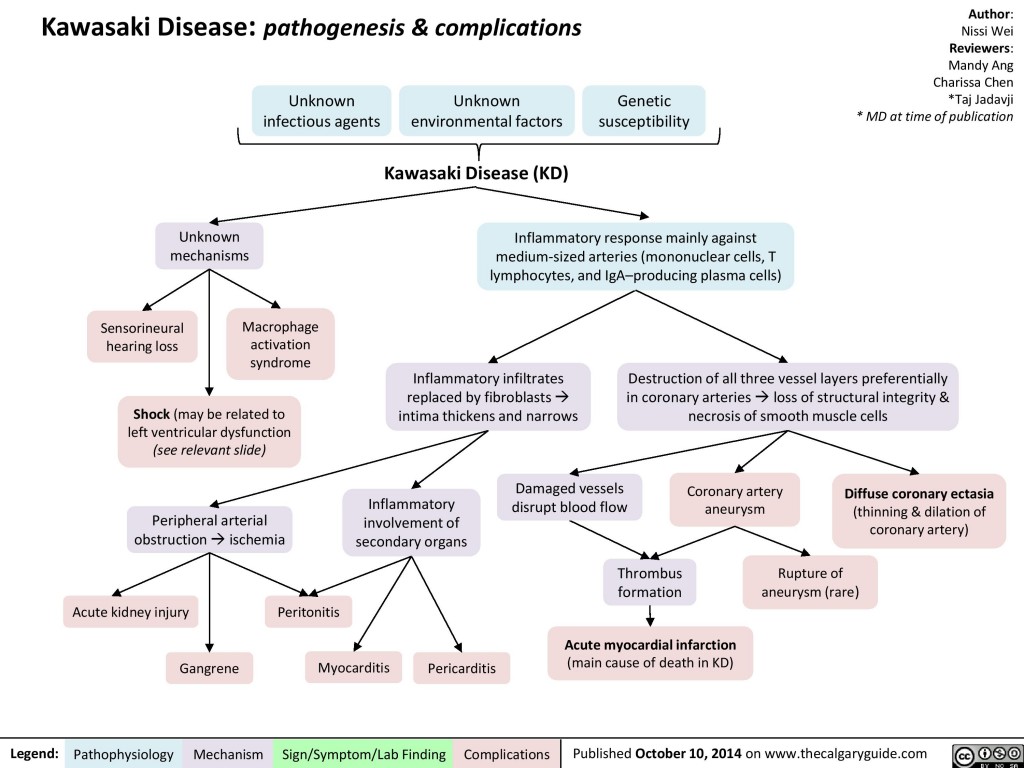Is A Single, Unknown Respiratory Virus The Cause Of Kawasaki Disease? New Data Suggests A Link

Table of Contents
The Mystery of Kawasaki Disease Etiology
Kawasaki disease, also known as mucocutaneous lymph node syndrome, is a systemic vasculitis primarily affecting children under the age of five. While its clinical presentation is well-defined, its etiology remains a significant medical enigma. The condition typically presents with a constellation of symptoms that can vary in severity.
- Symptoms: High fever lasting five days or more, characteristic rash, swollen lymph nodes (especially in the neck), conjunctivitis (red eyes), inflammation and swelling of the mouth and throat (strawberry tongue), and peeling skin on the hands and feet.
- Prevalence: Kawasaki disease is more prevalent in children under five years old, with boys slightly more affected than girls. It is also notably more common in children of Asian descent.
- Current Hypotheses: Several hypotheses have been proposed regarding the cause of Kawasaki disease, including genetic predisposition, environmental triggers, and infectious agents. Some researchers suggest that superantigens, potent immune system stimulants, may play a role.
- Lack of a definitive cause: The absence of a definitive causative agent represents a major challenge in managing and preventing Kawasaki disease. This uncertainty necessitates ongoing research to unravel the underlying mechanisms.
Emerging Evidence Linking a Respiratory Virus to Kawasaki Disease
While the exact cause remains unclear, a growing body of evidence suggests a potential link between Kawasaki disease and a specific, yet-to-be-identified respiratory virus. Several studies have observed an increased viral load in children diagnosed with Kawasaki disease, hinting at a potential infectious etiology.
- Increased viral load in Kawasaki disease patients: Research has shown higher levels of certain viral markers in the blood and tissues of children with Kawasaki disease compared to healthy controls. These findings suggest a possible viral infection preceding or triggering the disease.
- Specific viral families implicated: Although no single virus has been definitively identified, several studies have implicated viral families such as enteroviruses and adenoviruses. However, further research is needed to establish a direct causal relationship.
- Correlation vs. Causation: It’s crucial to acknowledge that correlation does not equal causation. The observed association between viral infections and Kawasaki disease requires further investigation to confirm a direct causal link. More research is needed to determine if the virus is a primary cause or a secondary infection.
- Geographic clustering and seasonal patterns: Some studies have noted potential geographic clustering and seasonal patterns in Kawasaki disease incidence, suggesting a possible influence of infectious agents, whose prevalence may vary geographically and seasonally.
Challenges in Identifying the Specific Virus
Despite the growing evidence implicating a respiratory virus, identifying the precise culprit has proven challenging. Several factors contribute to these difficulties:
- Rapid viral evolution: Many respiratory viruses, particularly RNA viruses, evolve rapidly, making it difficult to track and identify specific strains. Mutations can render diagnostic tests ineffective.
- Lack of sensitive diagnostic tools: Current diagnostic methods may not be sensitive enough to detect novel or rapidly evolving viruses. The development of more sophisticated diagnostic tools is essential.
- Difficulty in isolating the virus: Isolating and culturing the virus in a laboratory setting can be challenging, hindering further investigation into its properties and pathogenicity.
- The need for advanced research techniques: Advanced research techniques such as next-generation sequencing and metagenomics are crucial for identifying novel viruses and analyzing complex viral communities.
Future Research Directions
Confirming the link between a specific virus and Kawasaki disease and identifying the responsible agent requires further investigation. Future research should focus on:
- Larger epidemiological studies: Larger, well-designed epidemiological studies are needed to confirm the association between specific respiratory viruses and Kawasaki disease incidence across diverse populations.
- Development of improved diagnostic tests: Developing more sensitive and specific diagnostic tests for detecting potential viral agents is essential for early diagnosis and intervention.
- Further investigation into viral pathogenesis: Research should focus on understanding the precise mechanisms by which the suspected virus might trigger the inflammatory response characteristic of Kawasaki disease.
- Pre-clinical and clinical trials for targeted treatments: Once the virus is identified, pre-clinical and clinical trials of targeted antiviral treatments could revolutionize the management of Kawasaki disease.
Conclusion
While the etiology of Kawasaki disease remains a significant puzzle, emerging evidence strongly suggests a possible link with a single, yet-to-be-identified respiratory virus. Further research is paramount to definitively identify this virus and elucidate its role in the pathogenesis of Kawasaki disease. This breakthrough could lead to significant improvements in diagnosis, treatment, and ultimately, prevention strategies. Continued investigation and collaborative efforts are essential to improve patient outcomes and address the considerable challenges presented by this complex disease. Stay informed about the latest developments in Kawasaki disease research to contribute to a better understanding of this important area of pediatric medicine.

Featured Posts
-
 Mondays Market Live Music Stocks Show Early Strength
May 30, 2025
Mondays Market Live Music Stocks Show Early Strength
May 30, 2025 -
 Mealm Alastqlal Mhtat Fy Msyrt Alkfah Alwtny
May 30, 2025
Mealm Alastqlal Mhtat Fy Msyrt Alkfah Alwtny
May 30, 2025 -
 Gaza Crisis Envoys Emotional Un Appeal For Children
May 30, 2025
Gaza Crisis Envoys Emotional Un Appeal For Children
May 30, 2025 -
 French Open Sinner And Djokovic Face Tough Competition
May 30, 2025
French Open Sinner And Djokovic Face Tough Competition
May 30, 2025 -
 Top Seeded Pegula Claims Charleston Championship After Collins Match
May 30, 2025
Top Seeded Pegula Claims Charleston Championship After Collins Match
May 30, 2025
